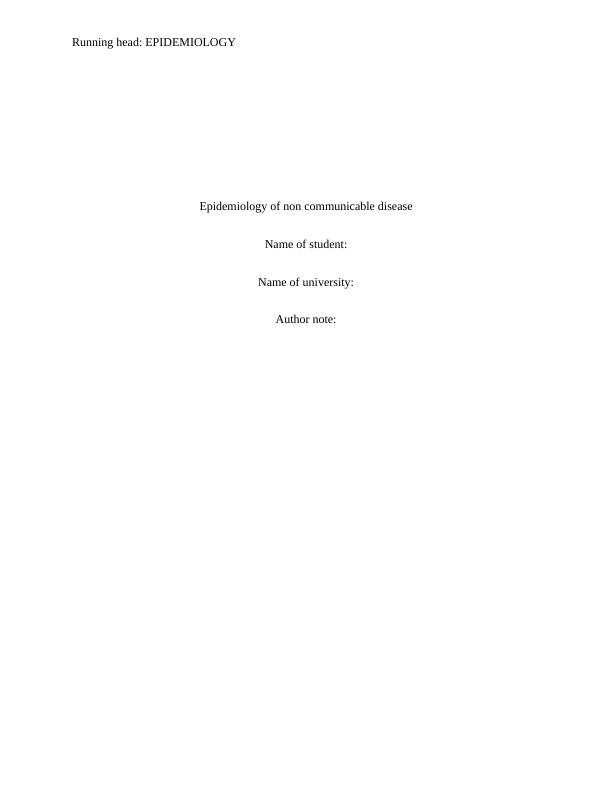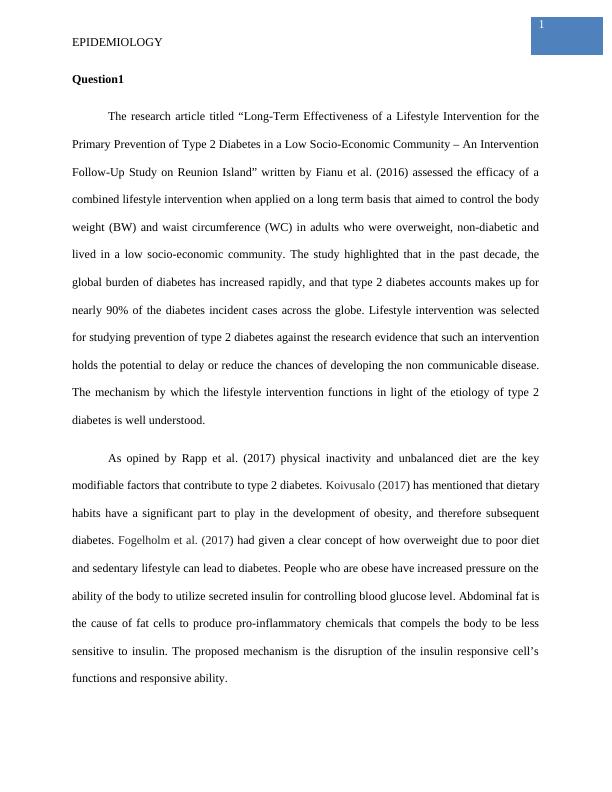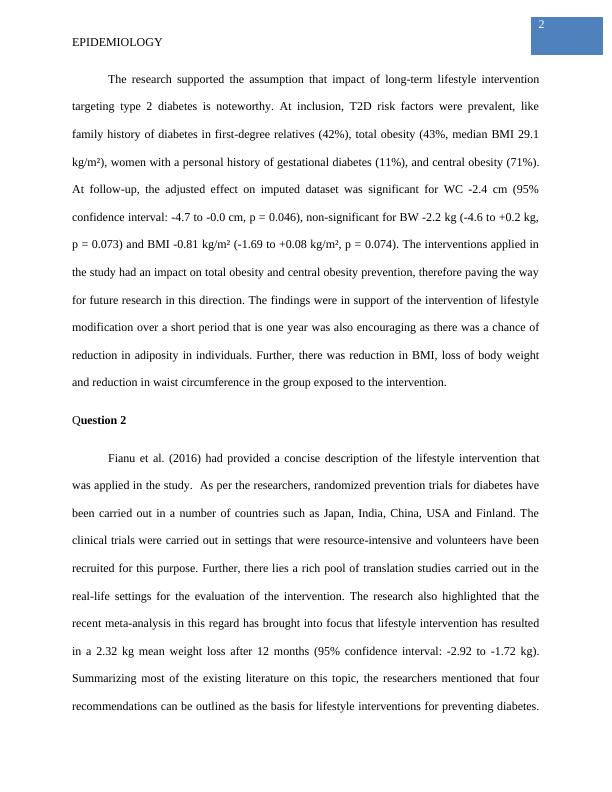Long-Term Effectiveness of a Lifestyle Intervention for the Primary Prevention of Type 2 Diabetes
Added on 2023-06-13
7 Pages1841 Words368 Views
Running head: EPIDEMIOLOGY
Epidemiology of non communicable disease
Name of student:
Name of university:
Author note:
Epidemiology of non communicable disease
Name of student:
Name of university:
Author note:

1
EPIDEMIOLOGY
Question1
The research article titled “Long-Term Effectiveness of a Lifestyle Intervention for the
Primary Prevention of Type 2 Diabetes in a Low Socio-Economic Community – An Intervention
Follow-Up Study on Reunion Island” written by Fianu et al. (2016) assessed the efficacy of a
combined lifestyle intervention when applied on a long term basis that aimed to control the body
weight (BW) and waist circumference (WC) in adults who were overweight, non-diabetic and
lived in a low socio-economic community. The study highlighted that in the past decade, the
global burden of diabetes has increased rapidly, and that type 2 diabetes accounts makes up for
nearly 90% of the diabetes incident cases across the globe. Lifestyle intervention was selected
for studying prevention of type 2 diabetes against the research evidence that such an intervention
holds the potential to delay or reduce the chances of developing the non communicable disease.
The mechanism by which the lifestyle intervention functions in light of the etiology of type 2
diabetes is well understood.
As opined by Rapp et al. (2017) physical inactivity and unbalanced diet are the key
modifiable factors that contribute to type 2 diabetes. Koivusalo (2017) has mentioned that dietary
habits have a significant part to play in the development of obesity, and therefore subsequent
diabetes. Fogelholm et al. (2017) had given a clear concept of how overweight due to poor diet
and sedentary lifestyle can lead to diabetes. People who are obese have increased pressure on the
ability of the body to utilize secreted insulin for controlling blood glucose level. Abdominal fat is
the cause of fat cells to produce pro-inflammatory chemicals that compels the body to be less
sensitive to insulin. The proposed mechanism is the disruption of the insulin responsive cell’s
functions and responsive ability.
EPIDEMIOLOGY
Question1
The research article titled “Long-Term Effectiveness of a Lifestyle Intervention for the
Primary Prevention of Type 2 Diabetes in a Low Socio-Economic Community – An Intervention
Follow-Up Study on Reunion Island” written by Fianu et al. (2016) assessed the efficacy of a
combined lifestyle intervention when applied on a long term basis that aimed to control the body
weight (BW) and waist circumference (WC) in adults who were overweight, non-diabetic and
lived in a low socio-economic community. The study highlighted that in the past decade, the
global burden of diabetes has increased rapidly, and that type 2 diabetes accounts makes up for
nearly 90% of the diabetes incident cases across the globe. Lifestyle intervention was selected
for studying prevention of type 2 diabetes against the research evidence that such an intervention
holds the potential to delay or reduce the chances of developing the non communicable disease.
The mechanism by which the lifestyle intervention functions in light of the etiology of type 2
diabetes is well understood.
As opined by Rapp et al. (2017) physical inactivity and unbalanced diet are the key
modifiable factors that contribute to type 2 diabetes. Koivusalo (2017) has mentioned that dietary
habits have a significant part to play in the development of obesity, and therefore subsequent
diabetes. Fogelholm et al. (2017) had given a clear concept of how overweight due to poor diet
and sedentary lifestyle can lead to diabetes. People who are obese have increased pressure on the
ability of the body to utilize secreted insulin for controlling blood glucose level. Abdominal fat is
the cause of fat cells to produce pro-inflammatory chemicals that compels the body to be less
sensitive to insulin. The proposed mechanism is the disruption of the insulin responsive cell’s
functions and responsive ability.

2
EPIDEMIOLOGY
The research supported the assumption that impact of long-term lifestyle intervention
targeting type 2 diabetes is noteworthy. At inclusion, T2D risk factors were prevalent, like
family history of diabetes in first-degree relatives (42%), total obesity (43%, median BMI 29.1
kg/m²), women with a personal history of gestational diabetes (11%), and central obesity (71%).
At follow-up, the adjusted effect on imputed dataset was significant for WC -2.4 cm (95%
confidence interval: -4.7 to -0.0 cm, p = 0.046), non-significant for BW -2.2 kg (-4.6 to +0.2 kg,
p = 0.073) and BMI -0.81 kg/m² (-1.69 to +0.08 kg/m², p = 0.074). The interventions applied in
the study had an impact on total obesity and central obesity prevention, therefore paving the way
for future research in this direction. The findings were in support of the intervention of lifestyle
modification over a short period that is one year was also encouraging as there was a chance of
reduction in adiposity in individuals. Further, there was reduction in BMI, loss of body weight
and reduction in waist circumference in the group exposed to the intervention.
Question 2
Fianu et al. (2016) had provided a concise description of the lifestyle intervention that
was applied in the study. As per the researchers, randomized prevention trials for diabetes have
been carried out in a number of countries such as Japan, India, China, USA and Finland. The
clinical trials were carried out in settings that were resource-intensive and volunteers have been
recruited for this purpose. Further, there lies a rich pool of translation studies carried out in the
real-life settings for the evaluation of the intervention. The research also highlighted that the
recent meta-analysis in this regard has brought into focus that lifestyle intervention has resulted
in a 2.32 kg mean weight loss after 12 months (95% confidence interval: -2.92 to -1.72 kg).
Summarizing most of the existing literature on this topic, the researchers mentioned that four
recommendations can be outlined as the basis for lifestyle interventions for preventing diabetes.
EPIDEMIOLOGY
The research supported the assumption that impact of long-term lifestyle intervention
targeting type 2 diabetes is noteworthy. At inclusion, T2D risk factors were prevalent, like
family history of diabetes in first-degree relatives (42%), total obesity (43%, median BMI 29.1
kg/m²), women with a personal history of gestational diabetes (11%), and central obesity (71%).
At follow-up, the adjusted effect on imputed dataset was significant for WC -2.4 cm (95%
confidence interval: -4.7 to -0.0 cm, p = 0.046), non-significant for BW -2.2 kg (-4.6 to +0.2 kg,
p = 0.073) and BMI -0.81 kg/m² (-1.69 to +0.08 kg/m², p = 0.074). The interventions applied in
the study had an impact on total obesity and central obesity prevention, therefore paving the way
for future research in this direction. The findings were in support of the intervention of lifestyle
modification over a short period that is one year was also encouraging as there was a chance of
reduction in adiposity in individuals. Further, there was reduction in BMI, loss of body weight
and reduction in waist circumference in the group exposed to the intervention.
Question 2
Fianu et al. (2016) had provided a concise description of the lifestyle intervention that
was applied in the study. As per the researchers, randomized prevention trials for diabetes have
been carried out in a number of countries such as Japan, India, China, USA and Finland. The
clinical trials were carried out in settings that were resource-intensive and volunteers have been
recruited for this purpose. Further, there lies a rich pool of translation studies carried out in the
real-life settings for the evaluation of the intervention. The research also highlighted that the
recent meta-analysis in this regard has brought into focus that lifestyle intervention has resulted
in a 2.32 kg mean weight loss after 12 months (95% confidence interval: -2.92 to -1.72 kg).
Summarizing most of the existing literature on this topic, the researchers mentioned that four
recommendations can be outlined as the basis for lifestyle interventions for preventing diabetes.

End of preview
Want to access all the pages? Upload your documents or become a member.
Related Documents
Dietary Planning Across the Lifespan Research Paper 2022lg...
|23
|3543
|51
Sharon’s Case Study: Diabetes, Obesity, and Kidney Failurelg...
|9
|2221
|78
Tackling Obesity: Improving Teenager Food Habits and Lifestylelg...
|14
|997
|149
Diet Plan and Anthropometric Measurements: A Case Studylg...
|9
|1732
|395
Screening Program for Obesity - Importance, Benefits, and Recommendationslg...
|7
|1898
|187
Factors and Strategies for Treating Adult Obesity in Englandlg...
|41
|14630
|291
